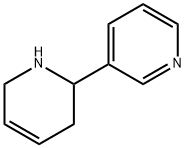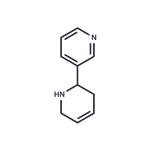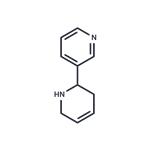(R,S)-Anatabine is a minor alkaloid produced in plants of the Solanaceae family, including tobacco. The detection of (R,S)-anatabine in urine is used as an indicator of tobacco use, particularly when nicotine-containing products (gum, patches, inhalers, and medications) are also being used. (R,S)-Anatabine increases nicotine self-administration and locomotor activity in rats. Of note, (R,S)-anatabine diminishes amyloid-β production in vitro and in vivo. (R,S)-Anatabine reduces (600 μg/ml) the transcription and protein levels of β-secretase, lowering the amount of Aβ (1-40) and Aβ (1-42) in a dose dependent manner in SHSY-5Y cells. (R,S)-Anatabine also dose dependently inhibits NF-κB activation.
A nicotine (N412420) metabolite.
(R,S)-Anatabine is a metabolite of Nicotine (N412420).
anatabine dose-dependently lowered aβ1-40 and aβ1-42 levels and reduced sappβ production without any effects on sappα levels. anatabine lowered aβ production by mainly impacting the β-cleavage of app. anatabine lowered nfκb activation. anatabine inhibited bace-1 transcription and reduced bace-1 protein levels in human neuronal like shsy-5y cells. (r,s)-anatabine also dose dependently inhibits nf-κb activation [1].
in a transgenic mouse model of alzheimer's disease, acute treatment with anatabine for 4 days significantly lowered brain soluble aβ1-40 and aβ1-42 levels [1].
[1] paris d, beaulieu-abdelahad d, bachmeier c, et al. anatabine lowers alzheimer's aβ production in vitro and in vivo[j]. european journal of pharmacology, 2011, 670(2): 384-391.



